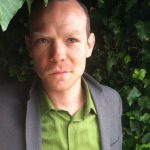Yoganatomy, ‘Outside of the Mat’ Thinking
Perelman School of Medicine has a new project which demonstrates using “outside of the box” thinking to make learning more accessible, and also lower stress levels of students’ lives.1 “Yoganatomy,” is a different type of yoga class, offered to first year students at Perelman. Yoganatomy combines traditional yoga with lessons in gross anatomy. For instance, an instruction a participant might hear is: “as you posteriorly tilt your pelvis, which muscles are contracting, which ones elongating?”
Building Awareness Builds Deeper Understanding of Bodily Structures
The class is taught to first year medical students in conjunction with anatomy lecture and gross anatomy lab (where they dissect cadavers). By building an awareness of how the body parts that were learned earlier in the day move in their own bodies, students build deeper understanding of the structures in the living body. In addition, it allows the students time to release some of their stress and tension.
Two-Fold Class Offers Education and Stress Relief in one Forward Fold
The class was developed by a yoga instructor and the anatomy professor a year ago. The yoga instructor who helped develop the program also attended the anatomy classes in order to learn the medical terminology and the physiological movements of all the bones and muscles. The class was originally conducted for only the first semester of the class, but was such a success that 2 additional sections have been added, taught by upperclassmen who have received yoga instructor training. The second in the sequence is called “medically informed yoga,” and also includes discussion on the physiological benefits of yoga, such as the changes in breathing, parasympathetic nervous system and blood pressure. There is a lot of research on yoga, which makes it a relevant topic for medical students.
Creativity Beyond the Mat and the Classroom
These classes demonstrate who networking and creativity can benefit a large group of individuals through the combination of elements that are not currently being used together. This program addresses students need to find stress relief as well as a novel way of studying material they are responsible for. It also gives a deeper inroad for holistic practices into conventional medical settings.
Image Copyright: <a href=’https://www.123rf.com/profile_elenaphotos21′>elenaphotos21 / 123RF Stock Photo</a>
 Node Smith, ND, is a naturopathic physician in Portland, OR and associate editor for NDNR. He has been instrumental in maintaining a firm connection to the philosophy and heritage of naturopathic medicine among the next generation of docs. He helped found the first multi-generational experiential retreat, which brings elders, alumni, and students together for a weekend camp-out where naturopathic medicine and medical philosophy are experienced in nature. Four years ago he helped found the non-profit, Association for Naturopathic ReVitalization (ANR), for which he serves as the board chairman. ANR has a mission to inspire health practitioners to embody the naturopathic principles through experiential education. Node also has a firm belief that the next era of naturopathic medicine will see a resurgence of in-patient facilities which use fasting, earthing, hydrotherapy and homeopathy to bring people back from chronic diseases of modern living; he is involved in numerous conversations and projects to bring about this vision.
Node Smith, ND, is a naturopathic physician in Portland, OR and associate editor for NDNR. He has been instrumental in maintaining a firm connection to the philosophy and heritage of naturopathic medicine among the next generation of docs. He helped found the first multi-generational experiential retreat, which brings elders, alumni, and students together for a weekend camp-out where naturopathic medicine and medical philosophy are experienced in nature. Four years ago he helped found the non-profit, Association for Naturopathic ReVitalization (ANR), for which he serves as the board chairman. ANR has a mission to inspire health practitioners to embody the naturopathic principles through experiential education. Node also has a firm belief that the next era of naturopathic medicine will see a resurgence of in-patient facilities which use fasting, earthing, hydrotherapy and homeopathy to bring people back from chronic diseases of modern living; he is involved in numerous conversations and projects to bring about this vision.
